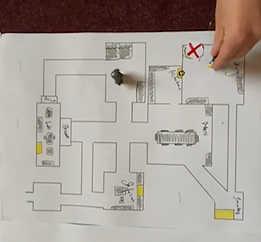Prototypes
Game Development (MA)
Engine: Clickteam Fusion, Unity
For the game development module, we worked on a project in four prototype stages: paper, 2D prototype, low-fi 3D and high-fi 3D. We were given the theme of "winter" to get us started.
Each prototype for this module, aside from the first one, was made as an iteration on the previous version. This meant that which each prototype, the game became more detailed and complicated in terms of mechanics.
The first prototype was done on paper in a team of four people. We were given the theme "winter" for this module, which led us to create a survival game set on an Arctic base that got snowed in. The goal of the game was to repair the communications tower and radio for help.

2D Prototype
Clickteam Fusion
2022
The 2D prototype was created using Clickteam Fusion. We took our initial idea and build upon it, essentially making the start of a reverse metroidvania where the player has to upgrade the base in order to stay alive and explore new sections. Furthermore, we expanded the narrative, allowing the player to interact with an NPC they also had to support and build a relationship with whilst uncovering the source of the base breaking down, which turns out to be some sort of hostile creature. We implemented several mechanics in this prototype like a heating system, light system and player needs management like hunger and sleep.
Low-fidelity
Prototype
Unity
2022

The low-fidelity prototype was the first 3D iteration and the first prototype created by myself rather than in a team. The prototype was created in Unity using Visual Scripting. The prototype includes the basic collection of items and locking doors to hide mechanics.
High fidelity prototype
Unity
2022

The High Fidelity Prototype was the final stage of the project. This showcased and elaborated on the ideas that were included in the previous 3D prototype. I further explored the locking and hiding mechanics as well as hunger and power management. The prototype features a larger map and assets from the Unity asset store. Due to the larger map size, there are more machines and doors to be interacted with.
The monster that was only hinted at within the previous versions was now visible on the outside of the environment, in the distance. Furthermore, in this version, the player was able to use the resources collected to set up a trap and stop the monster.
Dissertation
(BA)
Lethal Logic
Unity
2021

For my BA dissertation, I created a prototype using Unity. The prototype was a crime scene discovery and analysis game, where you collected and connected information to figure out the culprit. The prototype had two distinct sections that each had their own environment and mechanics.
The main purpose of the prototype was to create a game that accurately showcased the workload of a Crime Scene Investigator and a Forensic Scientist.This is because a large portion of forensic science representation in games is simplified to just picking up evidence and the game giving the player useful information.
Reflection
In a playthrough of the prototype, there are two main sections, a 3D discovery stage and a 2D investigation stage, The 3D discovery stage focuses on the collection and exploration of a crime scene. Then the player progresses to the 2D part of the prototype which was navigating the lab and using the machines to test the evidence collected in the 3D discovery stage. The objects would be tested via minigames and then information would be given to the player. Once the player is done carrying out tests then they can select a suspect from the character. It was a goal to try to explain and showcase the actual workflow of the forensics systems, specifically the roles of a Crime Scene Investigator and also a Forensic Science. The key point is that the two roles are often used interchangeably, whereas, in reality, the two roles work in completely different areas. While not included in the final project but it was planned to add that the evidence collected needs to be stored in specific areas to prevent contamination or destruction of evidence. Meaning that the player would have had to store the evidence collected at the scene in specific boxes or else it would not be able to be tested in the lab section of the game. This would have been to simulate the fact that if the evidence is not properly stored it can not be used in court due to the risk of contamination.









